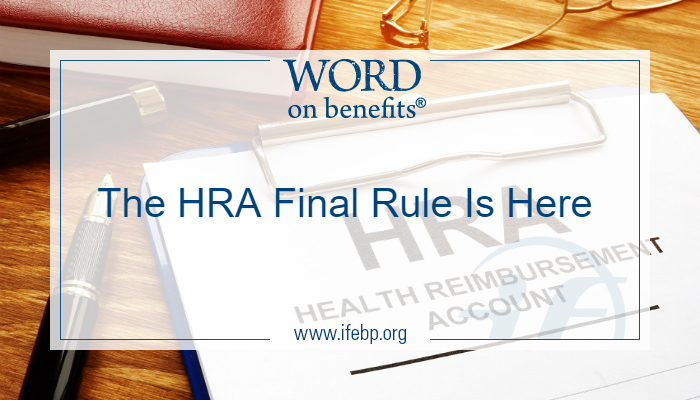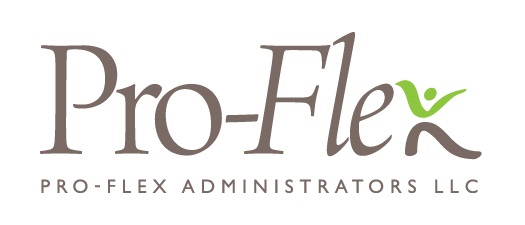On June 13, 2019, the Departments of Labor, Treasury, and Health and Human Services (the Departments) jointly issued a final rule to expand the flexibility and use of health reimbursement arrangements (HRAs) with a few notable changes from the proposed rule.
Original Source: https://blog.ifebp.org/index.php/hra-final-rule-ichra
The final rule creates two new types of HRAs—the individual coverage HRA (ICHRA) and the excepted benefit HRA. It also leaves all existing HRA designs intact (HRAs integrated with group health plans, qualified small employer HRAs (QSEHRAs), retirement HRAs, a standalone HRA for a single employee and the IRS-modified HRAs designed to be compatible with health savings accounts—limited-purpose HRAs, post deductible HRAs and suspended HRAs).
The final rule is effective August 19, 2019 and applicable for plan years beginning on or after January 1, 2020.
This two-part blog covers what you need to know about these two new types of HRAs.

Individual Coverage HRA (ICHRA)
The ICHRA harkens back to the pre-Affordable Care Act (ACA) nonintegrated HRA design and offers employers a true defined contribution option. The final rule allows any employer, regardless of size, to contribute pretax dollars to the ICHRA to subsidize premiums and/or qualified medical expenses for individual health plan coverage purchased by employees.
What qualifies as individual coverage?
Individual coverage includes insurance purchased in the ACA Marketplace (also known as the public exchange) or on private exchanges, student health insurance coverage and, in some cases, Medicare Parts A, B and C. The individual plan must cover more than just excepted benefits and must satisfy the ACA mandates banning annual limits on essential health benefits and requiring that preventive care services be provided without cost sharing.
How is individual coverage validated?
The ICHRA must provide a reasonable procedure so that participants can substantiate their coverage. Individual coverage must be validated annually (usually prior to the start of the plan year) and prior to the reimbursement of any claim. Employers are not required to validate employees’ attestations of qualified coverage unless they have actual knowledge that the ICHRA participant is not enrolled or will not enroll in coverage. The IRS provides a Model Attestation form.
Is the ICHRA a group health plan?
On its own, the ICHRA is a group health plan and generally subject to ERISA. Individual coverage policies are not a part of the ICHRA and do not become a group health plan for the purposes of ERISA so long as employers satisfy certain safe harbor conditions. Employers basically have to be “hands off” regarding the individual coverage just like other voluntary benefits.
Is the ICHRA integrated with a group health plan?
No. An employer may not offer a group health plan to a class of employees that is also offered an ICHRA. In other words, employees may not have a choice between an ICHRA or group health plan coverage. This limit is designed to protect the ACA Marketplace from adverse selection.
What are the allowable classes of employees?
Employers can create classes of employees based on certain employment distinctions, offering an ICHRA to some classes and a group health plan to others. Within a class, an ICHRA must be offered on the same terms to each employee. The final rule makes a number of changes to the permissible classes of employees and now includes:
- Full-time employees
- Part-time employees
- Salaried employees (new distinction in the final rule)
- Nonsalaried employees (new distinction in the final rule)
- Seasonal employees
- Temporary employees of staffing firms (new distinction in the final rule)
- Employees covered by a collective bargaining agreement in which the plan sponsor participates
- Employees working within the same insurance rating area as defined by ACA
- Employees who have not met the employer’s waiting period for medical coverage
- Nonresident aliens with no U.S.-source income
- New hires (e.g., current employees are enrolled in the group health plan and all new hires are offered the ICHRA).
(One proposed employee class was eliminated in the final rule—employees who have not attained age 25 prior to the beginning of the plan year—since this class is not based on a bona fide employment relationship.)
The final rule also allows the ICHRA to create more classes by combining these classes. For example, an allowable class distinction could be full-time collectively bargained employees vs. part-time collectively bargained employees.
Another change from the proposed rule is the addition of minimum class sizes, which vary based on employer size measured on the first day of the plan year, to protect the ACA Marketplace against adverse selection. These minimum class sizes only apply if the employer offers a traditional group health plan to at least one other class of employees, and they only apply to the class offered the ICHRA, not the class offered the group health plan. The new hire class and waiting period class are excluded from these minimums. The minimum class sizes are as follows.
- For employers with fewer than 100 employees, the class must be at least ten employees.
- For employers with 100 to 200 employees, the class must be at least 10 percent of the employees.
- For employers with more than 200 employees, the class must be at least 20 employees.
Despite suggestions submitted during the comment period, there is no separate class for former employees. If an ICHRA is offered to former employees, they are considered to be in the class they were in immediately before separation from service.
How much can an employer contribute?
There is no limit on how much an employer can contribute to an ICHRA, though employers may increase ICHRA contribution amounts for older employees or employees with more dependents. The maximum dollar amount available to the oldest participant may not be more than three times the amount available to the youngest participant and must be the same amount for participants of the same age.
What expenses can be reimbursed?
Besides individual coverage premiums, ICHRAs may also reimburse the same qualified medical expenses as other HRA designs as outlined in IRC Section 213(d). Employers have the flexibility to define which expenses will be reimbursed.
What if the ICHRA doesn’t cover the full premium for individual coverage?
If ICHRA doesn’t cover the full premium for individual insurance, the employer can set up a cafeteria plan, subject to all applicable cafeteria plan guidance, so that the employee can make pretax salary reduction contributions. The pretax contributions can be used to pay the remainder of the premium. This option is only allowed if the participant purchases individual coverage through a private exchange, not ACA Marketplace coverage. The cafeteria plan is not considered a group health plan for the purposes of the final rule.

Are there any other ACA considerations?
Yes. First, large employers with more than 50 full-time employees must still satisfy ACA affordability and minimum value requirements for group health plans (including an ICHRA) or pay the employer shared responsibility penalty. IRS Notice 2018-88 proposed safe harbors for how ICHRAs can satisfy this employer mandate, and final guidance is expected soon.
Second, if an ICHRA participant enrolls in ACA Marketplace coverage, he or she is not eligible for the health premium tax credit. This ineligibility must be communicated in the ICHRA plan notice.
Third, participants enrolled in an ICHRA must have the option to opt out and waive future reimbursements at least once a year. This opt-out requirement allows the participant to regain eligibility for health premium tax credits in the ACA Marketplace, though the participant can only get the tax credit if the ICHRA is deemed unaffordable and does not provide minimum value. The final rule clarifies that the plan may establish timeframes for enrolling in and opting out of the ICHRA, but participants generally must be provided an opportunity to opt out of the ICHRA once for each plan year, which must occur in advance of, and with respect to, the plan year.
Fourth, the final rule establishes that becoming newly eligible to participate in an ICHRA is a triggering event and qualifies that individual for a 60-day special enrollment period for ACA Marketplace coverage.
What notices are required?
ICHRAs must provide written notice at least 90 days before the beginning of the plan year for current participants and no later than the effective date of the ICHRA for newly eligible participants. The Department of Labor provides an ICHRA Model Notice, which contains ten specific pieces of information that must be included. Employers can include additional information.
Also, because the ICHRA is a group health plan subject to ERISA, ACA and other federal laws, all other standard reporting and disclosure requirements must be met (e.g., plan document, summary plan description, summary of benefits and coverage, etc.).
Anything else?
Here are a few miscellaneous considerations:
- Compatibility with health savings accounts: An ICHRA can be offered in conjunction with an HSA so long as the ICHRA only reimburses individual coverage premiums and not first-dollar cost sharing.
- COBRA: Employers must offer COBRA continuation for ICHRA coverage for all participants except those that lose ICHRA coverage for failing to maintain individual coverage.
Check back tomorrow for all the details on excepted benefit HRAs!
Resources
- Final Regulations, Federal Register, June 20, 2019
- Final Rule on Health Reimbursement Arrangements Could Shake Up Markets, Health Affairs, June 14, 2019
Developed by International Foundation of Employee Benefit Plans staff. This does not constitute legal advice. Consult your plan professionals for legal advice.
![]()
Rose Plewa, CEBS
Senior Instructional Designer, Online Learning Department at the International Foundation
Original Source: https://blog.ifebp.org/index.php/hra-final-rule-ichra






